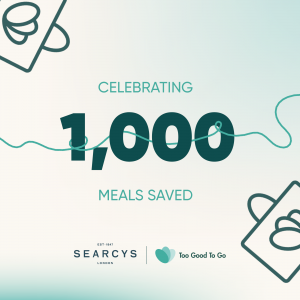-
A Friday Chat With Paschalis Loucaides, UK Manager For Too Good To Go
4 November 2021This week we have a special guest as part of our Friday Chat series to share some insight into the world of food waste. We are particularly proud of Searcys’ relationship with Too Good to Go, the number one app against food waste. Paschalis Loucaides is the platform’s UK Manager, a passionate advocate for sustainability in a way that makes sense for businesses.
Searcys has started working with Too Good To Go in 2019, and in 2020-21 has saved over 1,400 food bags from going into waste (this is the equivalent of 3,560kg CO2 or emissions from 630,116 smartphone chargers).
Hi Paschalis, tell us about yourself – how did you start in this industry, and how did you end up at Too Good to Go?
I’ve had a lucky career, I think it would be fair to say! I started in consumer goods, working in the marketing team for one of the big American FMCG companies. I have a family background in food, and the passion arose within me as I worked for some of the big high street restaurant chains – Carluccio’s, Pizza Express, and so on. Then I opened my own restaurant, all centred around beef and hamburgers: I was founder, MD, the man who cleaned bathrooms and tables, a front-of-house manager, a finance director, everything in one, and it was an invaluable experience. Then COVID hit, and I started to do more work on sustainability. Around that time, my son, who is now 10, challenged me, saying, “What are you doing about climate change, Dad?’ It wasn’t an innocent question; it was a good question. It resonated, and I decided to take time out to do a course at LSE on climate change and economics. So, my job at Too Good To Go – is a dream one. I use all my knowledge of sustainability, hospitality skills – and also use my marketing background.
We all know food waste is a problem, but can you explain the extent of the problem?
Yes, I’ll give you a couple of quick facts to exemplify it. The first is that 40% of all produced food is wasted. Think about that for a second… it means that four in ten potatoes that are grown with love, labour and resources never get to the plate. The statistic used to be a third, but the most recent studies show it’s 40%. There are certain pockets around the world where it’s going up dramatically. Alongside that food waste, there are challenges of food insecurity, not getting to people who need it, which makes this even worse. Another way to look at food waste is its CO2 equivalent. If food waste were a country, it would be the 3rd largest emitter of CO2 globally, after the US and China.
How can Searcys best help fight food waste?
I think the most important thing is that we’re having this conversation and sharing this information. Bringing food waste forward as a topic, not something to be scared of but as something to manage and minimise, is the first major step. On a practical basis, it’s not to be afraid to look at what’s going in the bin that shouldn’t be chucked away. These conversations are the core of what we do at Too Good To Go, other than providing a platform to redistribute your food waste. As a food redistribution platform, we aim to reduce our volumes, not to increase – sounds counterintuitive, but this allows us to have a shared objective with our clients, like yourselves.
And what about when it comes to food waste in events?
I have to be honest; I think you have a really hard job balancing customers’ perception of ‘plenty’ and the way you manage food waste when it comes to weddings, canapes, buffets, corporate events, etc. Essentially the trick is to maximise impact while minimising waste. With Too Good to Go we have that safety net – leftover food still goes into bellies. But there is no silver bullet for completely eradicating waste when it comes to food displays, and of course, it’s still essential for a company like Searcys to put on a bountiful, impressive display. The long-term aim is to educate the customer around being more comfortable with plate portions, so at least you don’t have plate waste. But that’s not a quick fix. The final and easiest point is let’s make sure there are lovely sustainable packaging options for people to take home.
And for event organisers, what are your tips on putting on a more sustainable event and prioritising this without blowing your budget?
Yes, this collaboration with the event organiser is also absolutely key, and it’s so great when you can be on the same page. For them, it’s as simple as looking at the menu with a food waste mentality, working with Searcys to bring this vision to reality. Also, having as many items as possible that can be prepared on-demand, rather than as a buffet. And again, there’s lots of opportunity for personalised sustainable packaging for people to take home as a lovely goodie bag from the event.
And away from Searcys, what are your top tips for home cooks reducing food waste on a daily basis?
Do what your grandma told you to do – plan meals, cook at home, don’t be afraid to write a list. My grandma was a very strict home economist, and list writing is a really simple thing that will save you from buying food you won’t be able to use. It’s also understanding the difference between a “best before” and a “use by” date. 10% food waste in the home is based on confusion on this. “Use by” is a no-brainer that you have to follow, whereas with “Best before” you can rely on look, smell, and taste to make a judgement.
And finally, as Searcys approaches its 175th Birthday, what are your wishes for the next generation of the company and how do you see the future?
What a fantastic milestone! Firstly, for Searcys specifically, it’s great to see a company that has such a long history but is continuing to innovate – it’s really rare to see and sets you in good stead.
For me, with a food waste lens, I think we’ll see a huge trend in the variety of sustainable food concepts that we have. I think we’ll start to be willing as a nation to pay for food that has a sustainability criterion. What do I mean by this? It can be producing food on demand, rather than pre-prepared, ordering in advance, carefully looking at your numbers, and planning. It is a joint effort of restaurateurs, caterers, event organisers, and, of course, consumers and guests.
This is maybe a five-year ambition rather than an immediate one, but we’re working very hard to bring this approach onto a Government agenda. As a nation, we’re not there yet, but I’m delighted we’re starting to see more pressure – consumer and legislative – and it’s a vast opportunity for operations to have a real edge in the next few years.
- ABOUT SEARCYS
- Restaurants and Bars
- Event Venues
- EVENT SPACES
- All Locations
- {10-11} Carlton House Terrace
- 30 Euston Square
- 41 Portland Place
- 116 Pall Mall
- Barber-Surgeons Hall
- Battersea Power Station
- Carpenters’ Hall
- Church House
- Gray’s Inn
- Horizon 22
- IET London: Savoy Place
- National Army Museum
- No. 11 Cavendish Square
- One Moorgate Place
- Saddlers’ Hall
- Searcys at The Gherkin
- EVENT SPACES cont.
- Event Types
- SEARCYS IN THE CITY
- SEARCYS ROLLS-ROYCE
- Let Us Find Your Venue
- Event Catering
- What’s On
- Contact Us
- ABOUT SEARCYS
- Restaurants and Bars
- Event Venues
- EVENT SPACES
- All Locations
- {10-11} Carlton House Terrace
- 30 Euston Square
- 41 Portland Place
- 116 Pall Mall
- Barber-Surgeons Hall
- Battersea Power Station
- Carpenters’ Hall
- Church House
- Gray’s Inn
- Horizon 22
- IET London: Savoy Place
- National Army Museum
- No. 11 Cavendish Square
- One Moorgate Place
- Saddlers’ Hall
- Searcys at The Gherkin
- EVENT SPACES cont.
- Event Types
- SEARCYS IN THE CITY
- SEARCYS ROLLS-ROYCE
- Let Us Find Your Venue
- Event Catering
- What’s On
- Contact Us
Saved Venues0Stay Connected with Searcys
Sign up to receive updates on exclusive events, restaurant offers, and more from Searcys.
- Restaurants and Bars
- Restaurants and Bars

